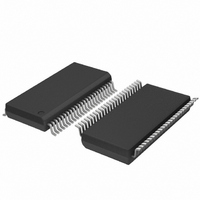SC28L201A1DGG,118 NXP Semiconductors, SC28L201A1DGG,118 Datasheet - Page 15

SC28L201A1DGG,118
Manufacturer Part Number
SC28L201A1DGG,118
Description
IC UART W/FIFO 48-TSSOP
Manufacturer
NXP Semiconductors
Series
IMPACTr
Datasheet
1.SC28L201A1DGG118.pdf
(110 pages)
Specifications of SC28L201A1DGG,118
Features
False-start Bit Detection
Number Of Channels
2, DUART
Fifo's
256 Byte
Voltage - Supply
3.3V, 5V
With Parallel Port
Yes
With Auto Flow Control
Yes
With False Start Bit Detection
Yes
With Modem Control
Yes
With Cmos
Yes
Mounting Type
Surface Mount
Package / Case
48-TSSOP
Lead Free Status / RoHS Status
Lead free / RoHS Compliant
Other names
935277824118
SC28L201A1DGG-T
SC28L201A1DGG-T
SC28L201A1DGG-T
SC28L201A1DGG-T
Philips Semiconductors
9397 750 13138
Product data sheet
7.2.3.1 Counter/Timer programming
7.2.1 Crystal oscillator
7.2.2 Baud rage generator (BRG)
7.2.3 Counter/Timer
7.2 Timing circuits
The crystal oscillator operates directly from a crystal, tuned between 7.0 MHz and
16.2 MHz connected across the X1/SCLK and X2 inputs with a minimum of external
components. BRG values listed for the clock select registers correspond to a
14.7456 MHz crystal frequency. Use of different frequencies will change the ‘standard’
baud rates by precisely the ratio of 14.7456 MHz to the different crystal frequency.
An external clock up to 50 MHz frequency range may be connected to X1/SCLK pin. If an
external clock is used instead of a crystal, X1/SCLK must be driven and X2 left floating or
driving a load of not more than 2 CMOS or TTL equivalents. The X1/SCLK clock serves as
the basic timing reference for the baud rate generator (BRG) and is available to the
programmable BRG (PBRG), counter-timers, control logic and the UART receivers and
transmitters.
The baud rate generator operates from the oscillator or external X1/SCLK clock input and
generates 27 commonly-used data communications baud rates (including MIDI) ranging
from 50 baud to 921.6 kBd. These common rates may be increased (up to 3.125 MBd)
when faster clocks are used on the X1/SCLK clock input. (See
Clock Select Register (RxCSR) and Transmitter Clock Select Register
these are available simultaneously for use by any receiver or transmitter. The clock
outputs from the BRG are at 16 (the actual baud rate).
Please see
asynchronous protocol may tolerate. Depending on character length it varies from 4.1 %
to 6.7 %.
The two Counter/Timers are programmable 16-bit dividers that are used for generating
miscellaneous clocks or generating time-out periods or counting characters received by
the receivers. Interrupts may be generated any time the counter passes through 0x00.
The counter/timer clocks may be used simultaneously by receiver, transmitter, I/O pin,
time-out logic, or interrupt.
The Counter/Timer is a 16-bit programmable divider that operates in one of four modes:
character count, counter, timer, and time-out. Character count counts characters. The
Timer mode generates a square wave or a pulse. If a square wave is programmed, the
counter counts down once for the HIGH portion, and once for the LOW portion of the
square wave. In the Pulse mode it counts down and outputs a pulse one-clock cycle.
Recall that the input to the counter may be from many places other than the X1 crystal
clock.
In the Counter mode it generates a time delay. In this mode, the counter effectively stops
at the end of the time-out, it does not continue until another START/STOP timer command
sequence is given. In the Time-out mode, it monitors the time between received
characters. If the time between any two characters is longer than the programmed time,
and interrupt is generated. This activity is similar to a receiver watchdog timer, but the true
meaning is that the data has stopped. The watchdog action indicates there is data in the
Section 7.2.3 “Counter/Timer”
Rev. 01 — 31 October 2005
3.3 V, 5 V UART, 3.125 Mbit/s, with 256-byte FIFO
for a description of the frequency error that the
© Koninklijke Philips Electronics N.V. 2005. All rights reserved.
Section 8.2.5 “Receiver
SC28L201
(TxCSR)”.) All of
15 of 110















